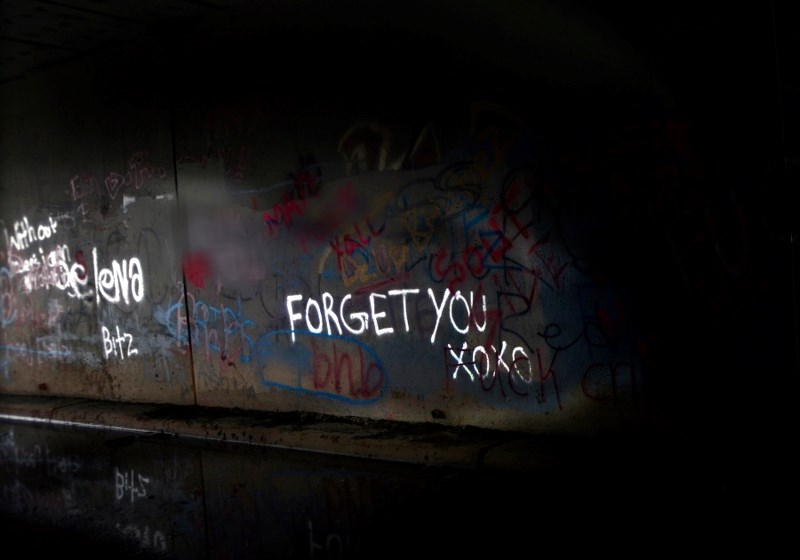Graffiti. Mischief. Colours.
These are a few of the signs a community will see as gangs develop, according to Darrel Bruno, an aboriginal gang and crime reduction coordinator with the RCMP “K” Division, Aboriginal Policing Services.
And these are also a few of the trends cropping up in the Stoney Nakoda First Nation’s townsite of Morley.
Bruno had a chance to see the activity in Morley firsthand May 21, as he presented the community with the aboriginal gang strategy.
“I would say Morley’s gang activity is at the lower end of the threshold,” said Bruno, a retired RCMP staff sergeant with more than 25 years under his belt. “There are some trends, but there are people here who want to meet the issue head on — not let it fester.”
Corporal Mel Calahasen of the Cochrane RCMP detachment echoes this sentiment. While Calahasen admitted the gang activity is not to the extreme of other First Nations communities, he said he wasn’t going to wait to act until drive-by shootings were a regular occurrence.
“Realistically speaking, the community is already being affected,” he said.
Calahasen estimated there are anywhere from eight to 10 gangs on the Nation at a given time. There are about 4,500 people living on the reserve.
Perhaps the most obvious mark of gang activity is the extensive graffiti tagging. Centralized to the townsite, the colourful tagging has been layered onto the walls of underpasses, the recreation centre and the buildings at Chiniki Village — among other locations.
Calahasen stressed the importance of the community in combating gang activity in the area — a notion Bruno was in complete agreement with.
“The police can’t fix this. The government can’t fix this. It’s up to the community,” said Bruno. “This is everyone’s problem.”
Bruno said the community of Hobbema has had much success implementing the strategy, adding the process has taken number of years. But the results speak for themselves.
“What we’ve seen in Hobbema is that through hard work there’s been a reduction in the number of gangs — it went from 13 gangs to three,” Bruno explained, adding that in 2005 police were responding to about four drive-by shootings a night. “It went from 400 gang members to about 100 members.”
Bruno explained the aboriginal gang strategy has been built upon four pillars: increasing education and awareness in the community, engaging the community, enforcement, and the identification and development of effective exit and intervention strategies.
A large percentage of Alberta’s aboriginal gangs consist of members aged 21 years and under. The strategy defines a gang as having three or more members with an identifiable leadership structure and a purpose of commissioning offences for financial/material gain.
Calahasen said members become involved in gangs for a number of reasons, including protection, family involvement and/or a search for acceptance.
Cathy Arcega and her team at the Bearspaw First Nation Youth Centre are working hard to provide youth with an alternative to these reasons. The Stoney Nation Youth Engagement Strategy, of which she is the project coordinator, aims to engage and empower the youth of the Stoney Nakoda First Nation.
The program is based on the Circle of Courage and is composed of components to make an effective gang-reduction initiative, but Arcega said the program isn’t designed to scare kids about gangs.
“We want the youth to be aware that the problem (of gangs) is out there,” she commented. “But they are welcome to come here to be in a safe environment, to learn new skills and have something else to do.”
The initiative is targeted at youth in Grades 6-8 and runs after school in an effort to keep kids busy during the hours of 3–6 p.m., when Arcega said many parents and caregivers aren’t around. The sessions range from sports and recreation, to more traditional and culture-based programming.
“This program is made to break the cycle of gangs,” said Vaughn Daniels, a youth worker at the centre. “We can get kids here instead of out there with their older cousins or brothers and whatever mischief they can get into. If we can get kids here, we can get them on a straight path.
“We put away the labelling and the judging. We’re trying to reach kids at their level. Every kid is like a book. You never know what a book is about until you read their story.”
Another alternative to engage Morley youth is the Stoney Tribal Cadet Corps, which is back up and running after a brief hiatus. Modelled after similar programs on other reserves (including Hobbema) and initiated by Calahasen, the program aims to provide youth with an alternative to joining a gang.




